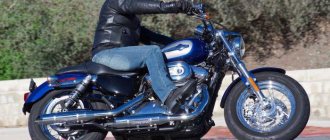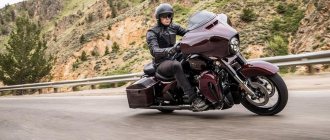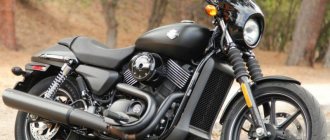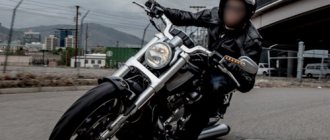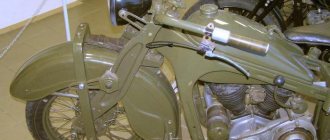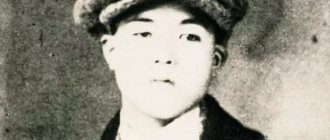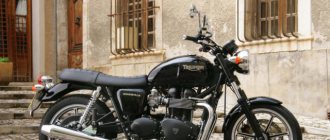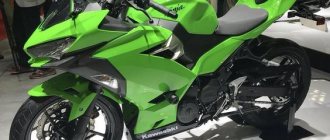photo: resurgencegear.co.nz
At the turn of the century, a new invention swept across America: the bicycle. This two-wheeled wonder allowed people to travel further and faster than ever before, and millions of people set out to explore the country by pedaling.
But that wasn't enough for 21-year-old William S. Harley and 20-year-old Arthur Davidson. In 1901, these two boys began their search, wondering how else they could make cycling easier.
“Their dream was to build a motorized bicycle that would allow people to travel reliably and as quickly as the technology of the time would allow.”
Realizing that they would need a skilled mechanic to achieve their dream, the duo enlisted the help of Arthur's brother, Walter Davidson, a railroad engineer whom they lured from his job in Kansas with the promise of a ride on their motorcycle. After arriving in Milwaukee, Walter discovered that he would have to help William and Arthur build their motorcycle before he could ride it. But he decided to stay anyway. Davidson's older brother William also offered to help.
Harley-Davidson creation of the first motorcycles
They worked in their first factory, a wooden shed in the backyard of a house measuring 10 by 15 feet with the sign "Harley-Davidson Motor Company" on the door. William Harley was given the first place in the company name because it was his idea to build a motorcycle. Four men produced their first three motorcycles in 1903.
Wooden shed "Harley-Davidson"
Like all their early motorcycles, the 1903 Harley-Davidson had a bicycle-type, single-cylinder engine, pedals and a leather drive belt. To get going, the motorcyclist first simply had to pedal the bicycle until the engine compression kicked in, then the miracle of technology roared and accelerated.
Harley-Davidson's next few years can be summed up in two words: growth and development. The partners produced three motorcycles in 1904 and seven more the following year. The company grew so fast that Davidson's backyard could no longer accommodate it.
In 1906, Harley and the Davidson brothers built a new plant on Juneau Avenue in Milwaukee and produced a record 50 cars. The company was officially incorporated in 1907, and by 1909 they had doubled the size of their factory, hired 35 employees, and increased production to 1,000 motorcycles per year.
William Harley and Arthur Davidson
Obsessed with improving his invention, Harley began working on the invention of the two-cylinder engine. After a difficult start in 1907, he improved the model in 1909. The new engine, called a V-twin, could propel the bike to 60 mph.
Thanks to the success of the V-double, the company quickly developed a reputation. Construction of reliable and extremely fast motorcycles, the annual production of which grew to 3,200 machines by 1910.
Harley Davidson history of famous motorcycles
To create excitement and promote sales, Harley-Davidson sponsored a racing team called "The Wrecking Crew", which became known for its racing brand.
The first motorcycle from Harley Davidson
The racing team took victory after victory, keeping it in the news and driving sales. To stay ahead of the competition, the company invested most of its profits into engineering and improving its motorcycles.
Harley-Davidson's next big breakthrough came in 1912, when Harley improved the chain drive to replace the outdated leather drive belt. A few years later in 1916, Harley came up with the step-starter, which eliminated the need for pedals and finally took the motorcycle away from its bicycle origins.
The fastest cars in the world: hypercars and sports cars
But many people, including the US government, still relied on bicycles as an inexpensive means of transportation. Looking for other ways to sell his company's product, Arthur became determined to convince government officials that motorcycles could replace bicycles in the US Postal Service and many other government agencies.
Arthur's strategy worked. By 1914, the US Postal Service had more than 4,800 Harleys delivering mail. The military was also attracted to the strong and fast "bike motors" and Harley sales soared.
By 1920, production had reached 28,189 velomotors per year, and Harley-Davidson had become the largest motorcycle manufacturer in the world, with dealerships in 67 foreign countries. In the early 1920s, the country experienced an economic depression, which led to a drop in sales. In addition, the motorcycle faced competition from Henry Ford.
Harley-Davidson in police service
As part of his survival plan, Harley-Davidson convinced American police departments that the fast, nimble motorcycle was the ideal vehicle for law enforcement. By mid-decade, more than 2,900 sheriffs and state patrol officers were using Harley-Davidsons. The boots, gaps, and saddlebags gave motorcycle cops a "Wild West" look that excited young boys and captured public interest.
Walter recognized the appeal of this "motorcycle look" and started a company selling Harley-Davidson accessories and apparel. A clever marketing move helped the company weather the economic downturn of the 1920s and created a market for additional equipment that has created much of the company's success to this day.
| The most expensive motorcycle in the world |
Thanks to smart marketing and further improvements, including larger engines and front brakes, Harley-Davidson sales began to slowly increase, and by 1928, more than 22,000 motorcycles were being produced per year.
The stock market crash of 1929 stopped motorcycle sales. By 1933, production had dropped to 4,000. In order to regain sales, Harley partially redesigned the motorcycle, replacing the standard Harley-Davidson block letter logo with a new art-deco tank design with a perfectly stylized eagle. The company has also started offering the bikes in a variety of different color schemes.
Development continued and in 1936 Harley released its EL model. Featuring an engine that can deliver twice the power, a new frame, new suspension and new styling. The EL was a major breakthrough for the company. These new motorcycles hit the road and began to revive sales. Production rose to 10,000 units per year, where they would remain until the end of the decade.
The advent of World War II will further increase the company's production and sales. Harley built and shipped more than 90,000 of its military motorcycles overseas for Allied use.
Harley-Davidson V-Rod 360
After World War II, Americans eagerly returned to motorcycles. To meet growing demand, the company acquired additional production facilities in the Milwaukee suburb of Wauwatosa in 1947. By the time Arthur Davidson (the last of the original founders) died in 1950, Harley-Davidson had become the undisputed king of the road.
Over the next four and a half decades, Harley-Davidson experienced a series of ups and downs, as well as competition from the Japanese. True to the tradition of quality and development established by its founding fathers, Harley-Davidson remains the only survivor of 300 American motorcycle manufacturers.
tags: Harley Davidson history, Harley-Davidson, Harley-Davidson company, brand
23.05.2018 16:04
Harley-Davidson Motorcycles - The Complete History
Everything has its beginning and end. The first years of the existence of the young Harley-Davidson company in the first decade of the twentieth century passed unnoticed. At that time, there were several dozen similar motorcycle studios in the States, and the motorcycle was nothing more than an ordinary bicycle with a motor.
Sergey Mochalov
Photo: Harley-Davidson, motorcycle-usa.com
Years passed, fierce competition served as the main factor in the natural selection of the best of the best. And less than half a century later, there was only one motorcycle brand left on the American market that conquered not only America but the whole world - Harley-Davidson.
1870 - Birth of William Davidson, Milwaukee, Wisconsin 1876 - Birth of Walter Davidson, Milwaukee, Wisconsin 1880 - Birth of William Harley, Milwaukee, Wisconsin 1881 - Birth of Arthur Davidson, Milwaukee, Wisconsin
The founders of the most famous motorcycle brand in the world: William Harley, William Davidson, Arthur Davidson and Walter Davidson.
1901 - William Harley created a design for an engine that could be installed on a bicycle
1903 - William Harley and his friend Arthur Davidson build their first motorcycle with a 116 cc engine. The motorcycle successfully passes “tests” on wooden velodromes of that time, intended for racing cyclists. William and Arthur's first workshop was a wooden garage located on Chestnut Street in Milwaukee. Currently, the head office of Harley-Davidson is located at this address.
The first Harley-Davidson was born here. Until the 1970s, the garage was located in the courtyard of the Harley-Davidson plant in Milwaukee, until it was accidentally destroyed by workers hired to clean the area.
1904 - The first official Harley-Davidson dealer opens in Chicago.
1906 - construction of the company's first assembly shop with an area of about 250 sq.m. is completed on Chestnut Street. At this moment, Harley-Davidson has 6 workers on its staff. The company's first product catalog is published.
1907 - William Davidson joins the company. Harley-Davidson becomes a joint stock company (Harley-Davidson Motor Company). The stockholders are William Harley and the three Davidson brothers.
1908 - Walter Davidson wins first place in the 7th Annual Federation of American Motorcyclists Endurance and Reliability Contest. And three days later he sets a record for engine efficiency - travels 188 miles (302.5 km) on one gallon (3.78 liters) of gasoline. Perhaps impressed by these achievements, the Detroit mayor's office orders a large batch of Harley-Davidson motorcycles for police use.
The first victory in competitions on a motorcycle of his own production in 1908 was won personally by the president of the company, Walter Davidson. In several stages he scores a record number of points, and Harley-Davidson products become famous.
The first victory in competitions on a motorcycle of his own production in 1908 was won personally by the president of the company, Walter Davidson. In several stages he scores a record number of points, and Harley-Davidson products become famous.
1909 - Harley-Davidson creates the first two-cylinder V-twin engine with a displacement of 811 cubic centimeters and 7 horsepower.
1911 - The single-cylinder "F" engine is invented and will power production HD motorcycles until 1929. The designation “F” comes from the fact that the intake valve ports are shaped like this letter of the English alphabet. The intake valve, as on modern engines, is located at the top of the engine, and the exhaust valve is located on the side.
1912 - Harley-Davidson begins shipping motorcycles to Japan. There are more than 200 official dealers of the company in the USA.
The first Harley-Davidson with a sidecar was designated J-18. It was equipped with the most powerful engine at that time and rear lights.
The first Harley-Davidson with a sidecar was designated J-18. It was equipped with the most powerful engine at that time and rear lights.
1914 - the first motorcycles with sidecars appear, equipped with a two-speed transmission. Belt drives are going out of fashion. Harley-Davidson is one of the latest motorcycle manufacturers to replace leather drive belts with iron chains. The main disadvantages of belts of that time were that they often flew off the pulleys, stretched and broke when wet. The chain drive was an important innovation of the time.
1915 - HD motorcycles with a three-speed gearbox go on sale.
1917 - About a third of the company's products are purchased by the Ministry of Defense. To train military mechanics, Harley-Davidson opens a Quartermasters School; at the end of the First World War, it is renamed the Service School. Dealer mechanics undergo training and on-the-job training there. [/img]
In 1917, Harley-Davidson was officially adopted by the US Army. In total, about 20,000 motorcycles were sent to the front.
1918 - almost half of the motorcycles produced were sold to the military and were actively used during combat operations in the First World War. After Germany signs surrender, Allied troops enter its territory. The first American to cross the border into Germany was Corporal Roy Holtz. He was riding a Harley-Davidson motorcycle.
1919 - The first Harley-Davidson sports model is introduced. It has a horizontally opposed engine with a volume of 600 cc. cm.
One of the divisions of Harley-Davidson is engaged in the design of exclusively sports motorcycle models. The company takes an active part in all competitions.
1920 - H-D becomes the largest motorcycle manufacturer in the world. The company has more than 2,000 official sales points in 67 countries. The company's racing team becomes the strongest in America. The team's mascot is a small pig, for this reason, the Harley Davidson motorcycle in the USA received the informal name “hog” - hog. This is what HD motorcycles are called to this day.
1925 - teardrop-shaped gas tanks begin to be installed on Harley-Davidson motorcycles, giving the company's products their own individual style. Before this, gas tanks had a flat top.
Harley-Davidson D, Harley-Davidson JD. Today's collectors are willing to pay tens of thousands of dollars for rare Harley-Davidson models from the 1920s.
Harley-Davidson D, Harley-Davidson JD. Today's collectors are willing to pay tens of thousands of dollars for rare Harley-Davidson models from the 1920s.
The first teardrop-shaped gas tank
1928 - A two-cylinder engine was first installed on JD series motorcycles, thanks to which the maximum speed reached 150 km/h. From the same year, Harley-Davidson began equipping motorcycles with a front brake.
1929 - Model D with a V-twin engine with a volume of 730 cc was first released. A distinctive feature of the engine is a flat top. It would be installed on Harley-Davidson motorcycles for the next forty years, undergoing minor modifications.
The stock market crash marks the beginning of the Great Depression. Despite this, Harley-Davidson manages to sell 21,000 motorcycles. The company remains the strongest of several dozen motorcycle brands that emerged from 1900 to 1930. Only a few of them will live to see the fourth decade of the twentieth century.
The first “cargo” Harley-Davidson
The first “cargo” Harley-Davidson
1932 - This year the famous three-wheeled Servi-Car was released - a favorite vehicle for street hamburger sellers and police officers. The motorcycle was discontinued after 41 years.
1933 is the worst year in the company's history. Sales dropped to 4,000 motorcycles.
1935 - Alfred Child, an agent for the Harley-Davidson Motor Company in Asia, comes to the conclusion that exporting motorcycles to Japan is becoming unprofitable and convinces the company's management to sell a license to manufacture Harley-Davidson motorcycles to businessmen from the land of the rising sun. The license is acquired by the Sankyo Seiyakyo company and soon the first Harley clones with the name Rikuo, which translates as “king of the road,” come out of its workshops.
Selling the license to manufacture motorcycles to the Japanese company Sankyo Seiyakyo was a profitable decision, but after three decades, cheap Japanese-made motorcycles that filled the American market almost caused the collapse of Harley-Davidson.
1936 - start of production of the EL model, which was equipped with a 1,000 cc engine. see with overhead valves. Among motorcyclists, this model was called the 'Knucklehead' - “Iron Head” - due to the shape of the valve covers. In the same year, Harley Davidson released a 1.3-liter engine with a side exhaust valve.
Harley-Davidson EL
1936 - WL model goes into production. William Davidson dies.
Harley-Davidson WL and WLA. “Liberator” was the name given to the Harley-Davidson WLA in Europe during World War II.
1941 - The United States enters World War II. The production of civilian motorcycles has almost completely stopped.
1942 - American troops in North Africa capture the first captured Zündapp and BMW. It turns out that Wehrmacht motorcycles are more suitable for heavy military service. Harley-Davidson and Indian companies produce about a thousand prototypes of motorcycles, the engine and drive shaft of which are copied from German ones. They were not widely used, but cost the American government an astronomical for that time $35,000 apiece. Walter Davidson dies.
1943 - William Harley dies
1945 - end of World War II. Over four years, 90,000 WLA model motorcycles were produced for the needs of the army.
1948 - Harley-Davidson engines of 1000 and 1200 cc are modernized. see with overhead valves. Aluminum cylinder blocks began to be installed on them.
Based on patents obtained by the US government as reparations after the surrender of Germany, Harley-Davidson released the Model S, later known as the Hammer.
1949 - production of the Hydra-Glide model began, on which a hydraulic fork was used for the first time.
Harley Davidson Hydra-Glide - the hydraulic fork uses coil springs with oil shock absorbers.
1950 Arthur Davidson dies.
1952 - according to company technicians, Indian two-cylinder V-twin engines are superior in performance to Harley-Davidson engines. The company's response was the 735 cc. see side valve motor with block design. The crankcase and gearbox are located in one housing.
One of the last Indian Cheif motorcycles from 1953.
1953 - Indian bankruptcy. Harley-Davidson Motor Company, which turned 50 this year, remains the only motorcycle manufacturer in the United States.
1957 - the Harley Davidson Sportster with a 900 cc engine capacity is introduced to the public. see also the upper location of the valves.
Harley-Davidson Sportster is the most affordable and smallest motorcycle model.
The Harley Davidson Duo-Glide was the first motorcycle to feature hydraulic shock absorbers on both the front and rear wheels.
1958 - The Duo-Glide model appears, which features the world's first hydraulic rear suspension.
1960 - Harley-Davidson recognizes that the small class of motorcycles also have some market potential and releases its first and only scooter, the Topper. In the same year, the company buys 50 percent of the shares of the Italian aircraft and motorcycle manufacturer Aeromacchi.
The Topper is the only scooter in the Harley Davidson line of models.
Harley Davidson Sprint is a motorcycle whose appearance can be seen from the Italian school of design.
1961 - the Sprint model appears, the appearance of which was developed by Aeromacchi designers. Thanks to its powerful engine and low center of gravity, it is gaining popularity among motorcycle racers.
1962 - Purchase of Tomahawk boat co. Fiberglass parts are beginning to be used in motorcycle designs.
1964 - The Servi-Car becomes the first Harley-Davidson motorcycle to feature an electric starter.
1965 - Electric starters begin to be installed on the Duo-Glide model, causing the model name to change to Electro-Glide
1966 - Complaints from motorcyclists that Harley-Davidson's engine was not powerful enough forced the company to modernize its 1000 and 1200 cc engines. The new valve cover was shaped very much like a shovel (shovel - in English), so the motorcycle with the updated engine began to be called “Shovelhead”. Over the next 20 years, this type of engine became the main one on Harley-Davidson motorcycles.
The Harley-Davidson Shovelhead is one of the most common models and was produced from 1966 to 1984.
The Honda CB750 Four is one of the most popular Japanese motorcycles in the USA, produced in various modifications from 1969 to 2003.
1969 - Despite the fact that Harley-Davidson Motor Company shares are traded on the stock exchange, there are not so many owners of these securities. This year, the main shareholders, under the threat of the so-called “Japanese Invasion,” as the planned entry of the Honda CB750 Four motorcycle into the American market was called, are selling a controlling stake in Harley-Davidson to American Machine and Foundry Co. At that time, AMF, although engaged in business in various industries, was generally known as a manufacturer of bowling balls. Under the new owner, the quality of the motorcycles produced dropped sharply.
1971 - By combining the steering wheel and front wheel of the XL model with the frame and engine of the FL model, the company's designers create the first cruiser - the FX 1200 Super Glide.
Harley-Davidson FX 1200 Super Glide
1973 - A new assembly plant for Harley-Davidson Motor Company opens in Pennsylvania.
1977 - the FXS Low Rider and 1977 XLCR models appeared - the latter motorcycle is now the object of hunting for collectors, although in 1977 almost no one wanted to buy it. A total of 3,100 1977 XLCR motorcycles were produced and production had to be curtailed the following year. Previously unused 1977 XLCRs could be found in dealer showrooms until the early 80s.
Harley-Davidson XLCR and Harley-Davidson FXEF are symbols of one of the most difficult periods in the life of the company.
1979 - Production of the FXEF model began. This motorcycle received the unofficial name “Fat Bob” due to its two gas tanks and “blown” fenders.
1980 - FLT, FXB Sturgis models with a 1300 cc engine were launched. see and FXWB Wide Glide.
Belt drive is coming back into fashion. Some models use a Kevlar belt instead of a chain.
Models Harley-Davidson FLT, Harley-Davidson FXB Sturgis, Harley-Davidson FXWB Wide Glide
1981 - Years of ineffective management led to the fact that Harley-Davidson lost the trust of customers, and profits fell sharply. When several investors, led by Vaughn Beals, proposed that AMF management buy out Harley-Davidson Motor Company for $75 million, the deal was approved. After this, the Harley-Davidson company is doing much better. Beals imposes strict quality standards on production sites and funds new developments.
Enthusiastic investors who breathed new life into Harley-Davidson. Vaughn Beals is on the far right below.
The FXRS Super Glide II is the first product of the new management team.
1982 - FXR/FXRS Super Glide II released.
The company's management continues to work to reduce production costs and improve the quality of motorcycles.
1984 - a new model engine, the 1340cc V2 Evolution, is installed on five models of Harley Davidson motorcycles. It is characterized by high reliability and low oil consumption.
1987 - the company conducts an IPO. Harley-Davidson Motor Company's ticker symbol on the New York Stock Exchange is designated HOG. Experts note that Harley Davidson motorcycles are capable of adequately competing with Japanese motorcycles even without the government applying protective duties.
Engine 1340cc V2 Evolution
Harley-Davidson FLSTF Fat Boy is one of the company's most popular models
Harley-Davidson FXDB Dyna Glide Sturgis
1990 - production of the FLSTF Fat Boy model began.
1991 - The first motorcycle in the Dyna model line, the FXDB Dyna Glide Sturgis, was introduced to the public.
1992 - Harley-Davidson becomes the first company to use drive belts on all motorcycle models. They are more durable than chains and require no maintenance.
1995 - A fuel injection system begins to be installed on all new motorcycle engines.
1996 - A workshop for the production of Harley-Davidson spare parts and components opens in Wisconsin, with an area of 23,000 square meters. m.
In the mid-90s, Harley-Davidson Motor Company began to actively conquer new markets and expand existing production.
1997 - The Harley-Davidson design bureau opens in Milwaukee. Production of the FL engine begins at the Menomonee Falls plant acquired by the company. Sportster production moves to a new manufacturing facility in Kansas City.
1998 - the company opens its first branch abroad - a factory in the Brazilian city of Manaus.
1999 - The new Twin Cam 88 engine begins to be installed on motorcycles of the Touring and Dyna model lines.
2000 - Despite tens of thousands of dollars spent on legal fees, Harley-Davidson Motor Co. abandons attempts to patent the characteristic “Harley” sound of the engine.
2001 - The VRSCA V-Rod is introduced. The engine, in the creation of which Porche specialists took part, is equipped with an injector, a liquid cooling system and an overhead camshaft.
Harley-Davidson VRSCA V-Rod
2003 - 100th anniversary of Harley-Davidson. About 250,000 guests come to Milwaukee for special events.
2006 - A 6-speed gearbox is installed on Dyna motorcycles for the new model year. The company's management announces the start of construction of the Harley-Davidson Museum.
Harley-Davidson Museum in Milwaukee
Harley Davidson XR1200
2008 - The opening of the Harley-Davidson Museum coincides with the 105th anniversary of the company.
Purchase of MV Agusta for $109 million in order to more successfully promote Harley-Davidson products on the European market.
The XR1200 model, developed specifically for Europe, has been introduced. Subsequently, it is successfully sold throughout the world.
2009 - the company is headed by Keith Wandell, since 1981 this is the first time that shareholders have appointed a top manager who was not previously associated with Harley-Davidson Motor Company. Due to the economic crisis, the MV Agusta division has to be put up for sale. The company's profit compared to the previous year is reduced by 84%. Harley-Davidson's plan to enter the fast-growing Indian market has been unveiled.
Harley-Davidson - To be continued...
